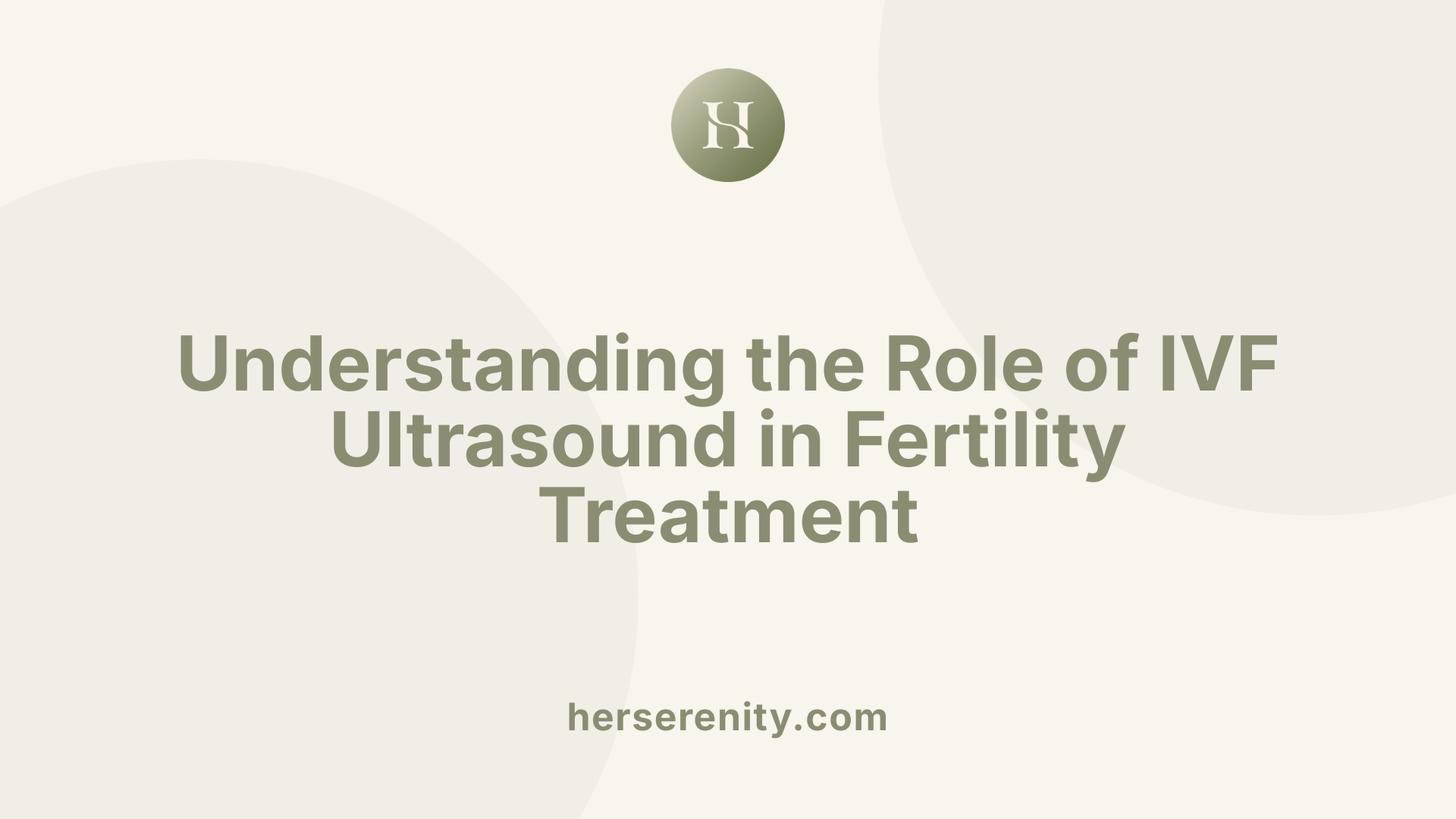What to expect during your first IVF ultrasound
Preparing for Your First Big Step in IVF Journey

Understanding the significance of your inaugural IVF ultrasound
Embarking on in-vitro fertilization (IVF) is both an exciting and anxious time. A pivotal milestone in this process is the first ultrasound, often referred to as the viability scan. This initial imaging session offers critical insights into your pregnancy's development, helping to confirm viability, assess early fetal health, and guide subsequent treatment steps. Knowing what to expect can ease nerves and empower you through this important phase.
What is an IVF ultrasound and what is its purpose?

Monitoring ovarian follicle development
An IVF ultrasound is a crucial imaging tool used throughout the fertility treatment process. Its primary purpose is to monitor the growth and development of ovarian follicles, which contain the eggs. During ovarian stimulation, ultrasounds are performed every few days to track follicle size, ensuring they mature appropriately. These images help doctors decide when to administer the final hormone trigger shot, which prepares the eggs for retrieval.
Assessing uterine lining health
The ultrasound also examines the uterine lining, or endometrium. A thick, healthy lining is essential for embryo implantation. Ultrasound images assess whether the lining is receptive or if adjustments in medication are needed. This evaluation helps optimize conditions for a successful pregnancy.
Guiding procedures like egg retrieval and embryo transfer
Ultrasound guidance is vital for procedures such as egg retrieval and embryo transfer. During egg retrieval, it directs the needle that collects eggs from the ovaries, ensuring safety and efficiency. Similarly, during embryo transfer, ultrasound helps precisely place embryos into the uterus, increasing chances of implantation.
Confirming pregnancy viability and early development
After embryo transfer, ultrasounds are performed around the sixth to seventh week of pregnancy to confirm viability. The images reveal a gestational sac, yolk sac, and fetal heartbeat, confirming that the pregnancy is progressing normally. Early detection of multiple pregnancies or abnormalities is also possible through these scans.
Ultrasounds during IVF are typically performed transvaginally, providing clearer images of internal reproductive structures without causing harm. They are safe, non-invasive, and essential for guiding treatment and monitoring progress at each stage of the IVF cycle.
Timing of the first IVF ultrasound

When is the first ultrasound typically scheduled during an IVF cycle?
The first ultrasound after IVF is usually scheduled between 6 to 7 weeks of pregnancy. This timing corresponds to approximately three to five weeks after the embryo transfer, depending on individual development and specific clinic protocols.
Scheduling the ultrasound during this window is essential because it allows enough embryonic development to visualize vital pregnancy structures. At this stage, doctors can confirm the presence of a gestational sac, yolk sac, and possibly detect the fetal heartbeat.
The ultrasound provides crucial information about the viability of the pregnancy. It helps verify that the pregnancy is intrauterine, rules out ectopic pregnancy, and determines whether it is a singleton or multiple pregnancy.
Performing the ultrasound at around 6 to 7 weeks offers the best chance to evaluate normal progression and address any initial concerns early in pregnancy. It’s an important milestone that provides reassurance for the expectant mother and healthcare team.
This timing also aligns with the natural developmental milestones of the embryo, including the appearance of the heartbeat, which is detectable at this stage with a heart rate averaging 90 to 110 beats per minute.
Ultrasounds performed at this time are most often vaginal scans, as they yield clearer images without harming the pregnancy. They are safe and non-invasive, helping to monitor early growth and detect potential issues promptly.
In summary, the first ultrasound scheduled between 6 and 7 weeks of pregnancy is a pivotal step in confirming successful implantation and early embryonic health, guiding further treatment and care.
Procedures involved during the first IVF ultrasound

What procedures are involved during the first IVF ultrasound?
The initial ultrasound in an IVF cycle is a crucial step in assessing the reproductive organs and planning treatment. During this initial scan, a transvaginal probe is usually used. This device is inserted into the vagina, providing clear, internal images of the uterus and ovaries. It allows doctors to evaluate the structure and health of these organs without discomfort and with high accuracy.
This ultrasound serves several purposes. First, it confirms that there are no ovarian cysts or abnormalities that could interfere with ovarian stimulation or pregnancy. It also measures the thickness of the endometrial lining, which must be receptive for successful implantation.
Throughout the IVF process, ultrasound scans are regularly performed to monitor follicle growth during ovarian stimulation. This helps determine the right timing to administer the trigger shot that matures the eggs, as well as the optimal time for egg retrieval.
When the eggs are ready, the ultrasound guides the eggs' aspiration through a thin needle inserted into the ovaries. This procedure ensures precise localization of follicles, making the egg collection safe and efficient.
After fertilization, during embryo transfer, ultrasound imaging guides the accurate placement of embryos into the uterus. This helps increase the chances of successful implantation by ensuring the embryos are positioned correctly within the uterine cavity.
In summary, the first IVF ultrasound involves a combination of procedures that include the use of a transvaginal probe, assessment of ovarian and uterine health, monitoring of follicle development, and guiding both egg retrieval and embryo placement. These steps are vital in maximizing the chances of a successful pregnancy through IVF.
What can be observed or detected during an IVF ultrasound?

What can be observed or detected during an IVF ultrasound?
During an IVF ultrasound, healthcare providers look for several important signs to assess the progress of fertility treatment and early pregnancy development. One of the primary focuses is the size and development of ovarian follicles, which are monitored carefully during stimulation cycles. These follicles contain the eggs and their growth helps determine the best time for egg retrieval.
The condition of the uterine lining, or endometrium, is also evaluated. A healthy, appropriately thickened lining is crucial for embryo implantation. Typically, the endometrial thickness is measured, and clinicians check for a smooth, uniform appearance free from irregularities or cysts.
As pregnancy progresses, the ultrasound confirms the placement of the embryo within the uterus. It visualizes the gestational sac, which appears as a dark area filled with amniotic fluid, usually measuring between 10 to 14 mm at the first ultrasound. The fetal heartbeat can often be detected from around the sixth week, with an average rate of 90 to 110 beats per minute, confirming embryo vitality.
In addition to these structures, ultrasound imaging enables early assessment of embryo growth, embryo-crown length, and overall pregnancy viability. If multiple embryos are transferred, the ultrasound helps identify whether it is a singleton or multiple pregnancy.
In summary, an IVF ultrasound provides vital information about ovarian follicle development, uterine health, embryo placement, and early signs of fetal development. These observations allow clinicians to confirm successful embryo implantation, monitor pregnancy progress, and detect any potential issues early on.
Normal findings during an IVF ultrasound and their significance

What are considered normal findings during an IVF ultrasound?
An IVF ultrasound provides essential information about the reproductive organs and the progress of the pregnancy. During a typical scan, several normal signs indicate that everything is developing properly.
Firstly, the presence of ovarian follicles is a critical aspect. These follicles should be adequately sized, usually reaching 18-20 mm in diameter just before egg retrieval. Such growth indicates that the ovaries are responding well to stimulation medications and that mature eggs are likely to be available for collection.
Secondly, the uterine lining, or endometrium, should be healthy, trilaminar, and measure between 7 to 12 mm. This thickness suggests that the uterus is receptive to embryo implantation. A lining that appears properly thickened and has a triple-layer appearance is a good sign of a supportive environment for early pregnancy.
The uterus itself should appear normal, without abnormalities such as fibroids, cysts, or lesions, which can interfere with implantation or pregnancy maintenance.
In early pregnancy, a gestational sac of approximately 6.25 mm in size is typically visible. Sometimes, a yolk sac is also seen alongside the gestational sac—both are signs of embryo development.
The detection of a fetal heartbeat, usually between 90 and 110 beats per minute, is a vital confirmation of embryo vitality. The presence of a heartbeat confirms that the pregnancy is viable at this early stage.
Together, these findings demonstrate that the ovaries, uterus, and early pregnancy are developing normally and align with expected benchmarks for that stage.
Emotional experience during the IVF ultrasound
What emotional feelings might one experience during an IVF ultrasound?
Undergoing an IVF ultrasound can be an emotional rollercoaster for many individuals. The anticipation builds as you prepare for this important scan, often filled with a mixture of hope and excitement about seeing signs of a developing pregnancy. When images of the gestational sac, yolk sac, or even a heartbeat are visible, feelings of relief and joy are common, reaffirming the pregnancy's progress.
However, it's normal to also feel nervous or anxious. The scan's findings can sometimes be uncertain or unexpected, leading to worries about potential complications like ectopic pregnancy or early pregnancy loss. For some, if the ultrasound does not show the expected signs or shows smaller-than-anticipated structures, feelings of disappointment or frustration might surface.
This emotional variability is natural, as each person's experience is uniquely influenced by their hopes, fears, and previous experiences. Support from healthcare providers plays a vital role in helping manage these feelings. Open communication, reassurance, and clear explanations can help reduce anxiety.
Coping strategies such as involving a partner or support person during appointments, practicing mindfulness, and seeking counseling if needed, can make this emotional journey more manageable. Recognizing these feelings as normal parts of the process can provide comfort and resilience during this hopeful yet sensitive time.
The importance of understanding your first IVF ultrasound
Your first IVF ultrasound is a crucial step in your fertility journey, providing vital information about pregnancy viability, embryo development, and the success of your treatment plan. While it can bring a mix of emotions, being informed about what to expect and the purpose of this scan can help ease anxiety and empower you during this significant milestone. Remember, each ultrasound is a reflection of your body's response and resilience, guiding your healthcare team in supporting a healthy pregnancy from its very early stages.
References
- First ultrasound after IVF: schedule and what to expect
- First pregnancy scan after IVF (In Vitro Fertilization) treatment
- First Ultrasound After IVF Treatment: Pregnancy Test & Scans - Ferty9
- What to Expect at My IVF Ultrasound Visit - University of Utah Health
- IVF Process Day by Day - In Vitro Fertilization Steps | CCRM
- First IVF Treatment Cycle: What to Expect - Fertility Institute of Hawaii
- The Ultrasound Schedule after IVF - Fertility Center of San Antonio



































































































